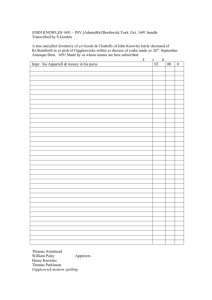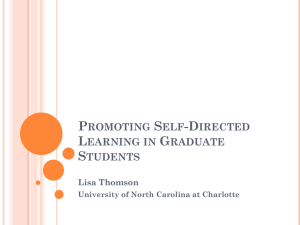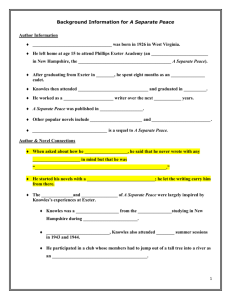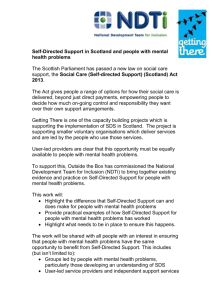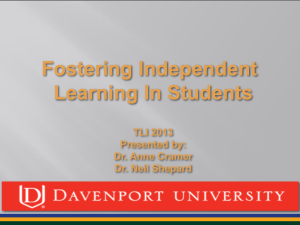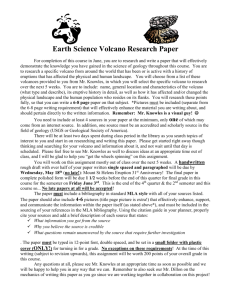Self-Directed Learning Model
advertisement
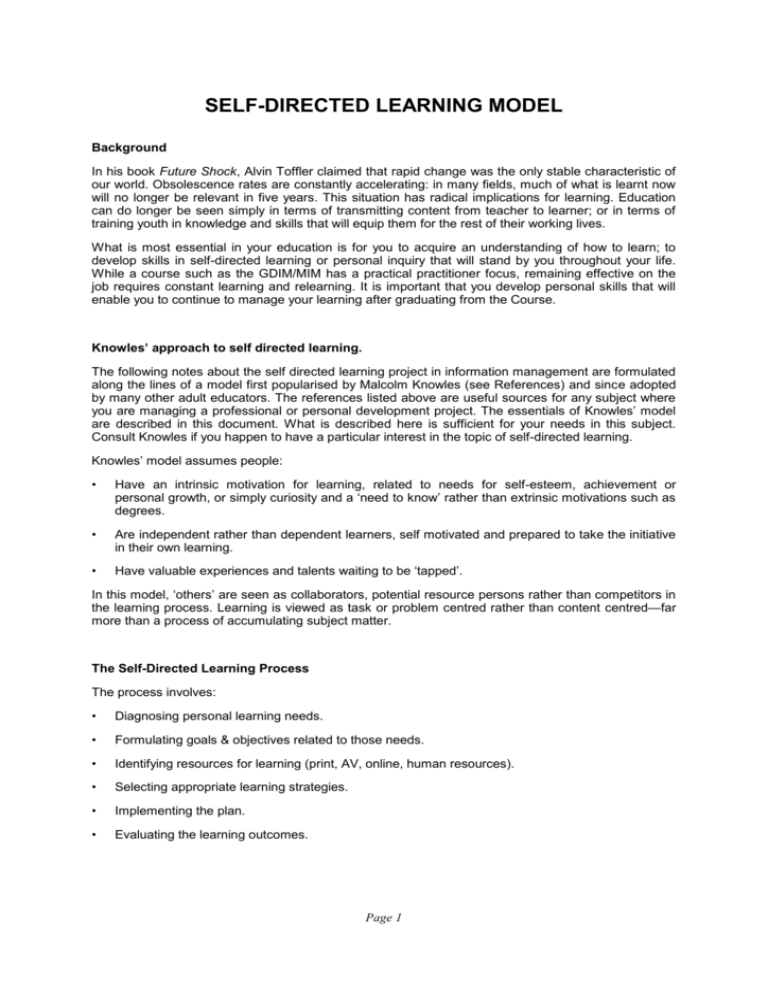
SELF-DIRECTED LEARNING MODEL Background In his book Future Shock, Alvin Toffler claimed that rapid change was the only stable characteristic of our world. Obsolescence rates are constantly accelerating: in many fields, much of what is learnt now will no longer be relevant in five years. This situation has radical implications for learning. Education can do longer be seen simply in terms of transmitting content from teacher to learner; or in terms of training youth in knowledge and skills that will equip them for the rest of their working lives. What is most essential in your education is for you to acquire an understanding of how to learn; to develop skills in self-directed learning or personal inquiry that will stand by you throughout your life. While a course such as the GDIM/MIM has a practical practitioner focus, remaining effective on the job requires constant learning and relearning. It is important that you develop personal skills that will enable you to continue to manage your learning after graduating from the Course. Knowles’ approach to self directed learning. The following notes about the self directed learning project in information management are formulated along the lines of a model first popularised by Malcolm Knowles (see References) and since adopted by many other adult educators. The references listed above are useful sources for any subject where you are managing a professional or personal development project. The essentials of Knowles’ model are described in this document. What is described here is sufficient for your needs in this subject. Consult Knowles if you happen to have a particular interest in the topic of self-directed learning. Knowles’ model assumes people: • Have an intrinsic motivation for learning, related to needs for self-esteem, achievement or personal growth, or simply curiosity and a ‘need to know’ rather than extrinsic motivations such as degrees. • Are independent rather than dependent learners, self motivated and prepared to take the initiative in their own learning. • Have valuable experiences and talents waiting to be ‘tapped’. In this model, ‘others’ are seen as collaborators, potential resource persons rather than competitors in the learning process. Learning is viewed as task or problem centred rather than content centred—far more than a process of accumulating subject matter. The Self-Directed Learning Process The process involves: • Diagnosing personal learning needs. • Formulating goals & objectives related to those needs. • Identifying resources for learning (print, AV, online, human resources). • Selecting appropriate learning strategies. • Implementing the plan. • Evaluating the learning outcomes. Page 1 Self-Directed Learning Model Selection of Project and Needs Analysis Project should be chosen because you sense a definite learning need in this area. Reasons for Using this Process There are several reasons for adopting this approach. The process allows you to customise your project to suit your needs and circumstances. Also, the process requires that you take your fair share of responsibility for ensuring that you do something that is worthwhile for you. This approach asks that you consider what is the educative value of your action learning project. It is easy to take a work-related project that only deals with knowledge, skills, and values where you are well versed. This process of relating needs to learning objectives, and learning objectives to strategies and opportunities allows you to review what you potentially might get from doing the project. Moreover, the format adopted allows you to document your ideas about potential gains so it might be easily communicated to someone else. Use of self directed action learning projects is a method of human resource development with which all managers need to be familiar. For some of you this approach may also be your first experience of a different education culture—one where the learner has to take greater responsibility. Its use is appropriate for management development. Its adoption does not lead to any lessening of standards and intellectual rigour. Developing a self directed learning project This process involves several steps. Step 1 Diagnose your learning needs A learning need is the gap between where you are now and where you want to be in regard to a particular set of competencies. You may already be aware of certain learning needs as part of staff evaluation process or the long accumulation of evidence for yourself of the gaps where you are now and where you would like to be. It not, you need to create a model of the competencies required to perform excellently the role you are concerned about. You can build your checklist of competencies from a combination of sources. A checklist may already exist. You can draw on other people such as colleagues and relevant experts. Extracting key points from authoritative textbooks can assist in the development of a checklist. A competency can be thought of as an ability to do something at some level of proficiency. It is usually composed of a combination of knowledge, understanding, skill, attitude and values For example, ‘ability to ride a bicycle from my home to the store’ is a competency that involves some knowledge of how a bicycle operates and the route to the store; an understanding of some of the dangers inherent in riding a bicycle; skill in mounting, pedalling, steering, and stopping a bicycle, an attitude of desire to ride a bicycle; and a valuing of the exercise it will yield. It is useful to produce a competency model even if it is crude and subjective because of the clearer sense of direction it will give you. Having constructed a competency model, your next task is to assess the gap between where you are now and where your model says you should be in regard to each competency. You can do this alone or with the help of other people. The chances are that you will find that you have already developed some competencies to a level of excellence, so that you can concentrate on those that you have not yet developed into sound competencies. Page 2 Self-Directed Learning Model Step 2. Specify your learning objectives. Each of the learning needs diagnosed in Step 1 can be translated into a learning objective. You will probably identify many more objectives than can dealt within in one project. When you come to specify your learning objectives it is useful to be able to distinguish a range of different types of objective. One useful classification of learning objectives is as follows. Behavioural aspect: Definition To develop knowledge about: KNOWLEDGE (Generalisations about experience; internalisation of information). To develop understanding of: UNDERSTANDING (Application of information and generalisations) To develop skill in: SKILLS (Incorporating new ways of performing through practice). To develop attitudes towards ATTITUDES (Adoption of new feelings through experiencing greater success with them than with old feelings) To develop values of: VALUES (The adoption and priority arrangement of beliefs) At this point, write out your preliminary ideas, identifying your key learning goals and learning gaps, and describing specific learning objectives. Ensure that your learning objectives describe what you will learn, not what you will do. State your objectives in terms that are most meaningful to you. Step 3: Specify learning resources and strategies You should also think about how you propose to go about accomplishing each objective. Identify the resources (material and human) you plan to use in your project. Then specify the strategies (techniques, tools) that you will employ in making use of those resources. For example, if you had the following learning objective, the following resources and strategies could be used. Learning objective Learning Resources and Strategies Improve my ability to organise my work efficiently so that I can accomplish 20 percent more work in a day 1. Find and read books and articles on how I can organise my work and manage my time. 2. Interview three executives on how they organise their work, then observe them for one day each, noting the techniques they use. 3. Select the best techniques from each, plan a day’s work, and have a colleague observe me for a day, giving me comments. Page 3 Self-Directed Learning Model Step 4: Specify evidence of accomplishment Decsribe what evidence of accomplishment you will collect to indicate the degree to which you have achieved each objective. The following examples of evidence for different types of objectives may help stimulate your thinking about what evidence you might accumulate. Type of Objective Examples of Evidence Knowledge Reports of knowledge acquired as in essays, examinations, presentations, annotated bibliographies. Understanding Examples of utilisation of knowledge in solving problems as in action projects, research projects with conclusions and recommendations, plans for change. Skills Performance exercises, videotaped performances with ratings by observers. Attitudes Attitudinal rating scales; performance in real situations, role playing, critical incident cases with feed back from participants and /or observers. Values Value rating scales, performance in value clarification groups, critical incident cases with feed back from participants and /or observers. Step 5: Specify how the evidence will be validated. Think about what criteria could be used to judge the evidence. The criteria will vary according to the type of objective. For example, appropriate criteria for knowledge objectives might include comprehensiveness, depth, precision, clarity, authentication, usefulness, etc. For skill objectives more appropriate criteria may be poise, speed, flexibility, precision. After you have specified the criteria, indicate the means you propose to use to have the evidence judged according to these criteria. For example, if you produce a paper or report, who will you have read it? How will these judgements be expressed? Step 6: Review your project After you have completed the first draft of your project plan, you may find it useful to review it with some other people, such as your work colleagues, to get their ideas and reactions. Here are some questions you might have them ask about your plan to get optimal benefit from their help: • Are the learning objectives clear, understandable, and realistic; and do they describe what you propose to learn? • Can they think of other objectives you might consider? • Do the learning strategies and resources seem reasonable, appropriate, and efficient? • Can the think of other resources and strategies you might consider? • Does the evidence seem relevant to the various objectives and would it convince them? • Can they suggest other evidence you might consider? • Are the criteria and means for validating the evidence clear, relevant, and convincing? Page 4 Self-Directed Learning Model Step 7: Carry out the project You now simply do what your project plan calls for. Keep in mind that as you work on it you may discover that your notions about what you want to learn and how you want to learn about it may change. So do not hesitate to revise your contract as you go along. Step 8: Reflection on your learning When you have completed your project you should review if you have learned what you set out to learn. In some instances, it will also be important to reflect on learning that occurred which was outside the scope of your initial objectives. Bibliography Knowles, M.S. (1975) Self directed learning: A guide for learners and teachers. Chicago: Cambridge Adult Education. Knowles, M.S. (1986) Using learning contracts. San Francisco: Jossey-Bass. Knowles, M. S., Holton, E. & Swanson, R.A. (1998) The adult learner: The definitive classic in adult education and human resource development. :Houston, TX.: Gulf Pub. Co. Toffler, A. (1971) Future shock. London: Pan BMcI/PB Page 5

